Pumping Station Desing - Second Edition by Robert L. Sanks, George Tchobahoglous, Garr M. Jones
Подождите немного. Документ загружается.

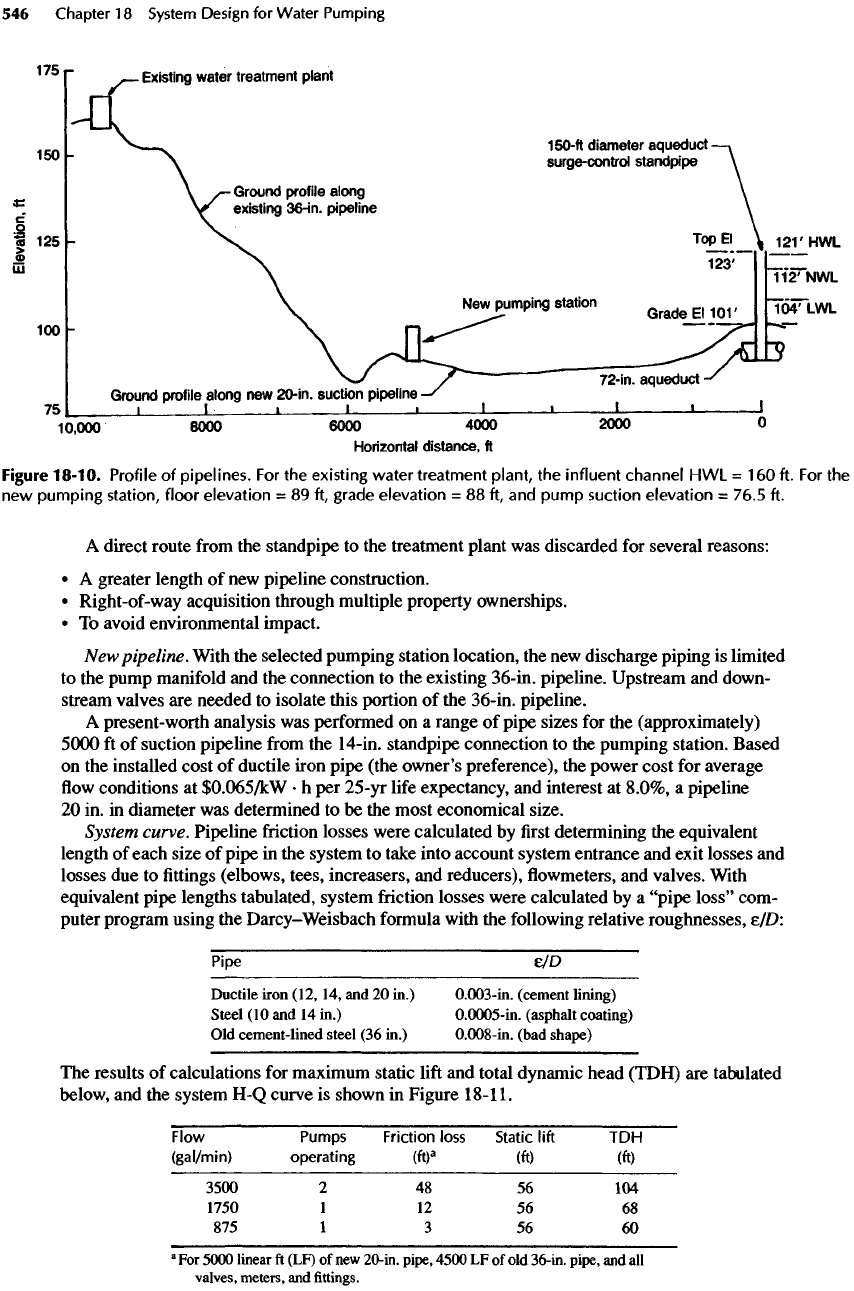
Figure
18-10.
Profile
of
pipelines.
For the
existing
water
treatment
plant,
the
influent
channel
HWL =
160
ft. For the
new
pumping
station,
floor
elevation
= 89 ft,
grade
elevation
= 88 ft, and
pump
suction
elevation
=
76.5
ft.
A
direct route
from
the
standpipe
to the
treatment plant
was
discarded
for
several reasons:
• A
greater length
of new
pipeline construction.
•
Right-of-way
acquisition through multiple property ownerships.
• To
avoid environmental impact.
New
pipeline. With
the
selected pumping station location,
the new
discharge piping
is
limited
to the
pump
manifold
and the
connection
to the
existing
36-in.
pipeline. Upstream
and
down-
stream
valves
are
needed
to
isolate this portion
of the
36-in. pipeline.
A
present-worth
analysis
was
performed
on a
range
of
pipe sizes
for the
(approximately)
5000
ft of
suction pipeline
from the
14-in.
standpipe connection
to the
pumping station. Based
on
the
installed cost
of
ductile iron pipe (the owner's preference),
the
power cost
for
average
flow
conditions
at
$0.065/kW
• h per
25-yr
life
expectancy,
and
interest
at
8.0%,
a
pipeline
20 in. in
diameter
was
determined
to be the
most economical size.
System
curve. Pipeline
friction
losses were calculated
by first
determining
the
equivalent
length
of
each size
of
pipe
in the
system
to
take into account system entrance
and
exit losses
and
losses
due to fittings
(elbows, tees, increasers,
and
reducers),
flowmeters, and
valves. With
equivalent pipe lengths tabulated, system
friction
losses were calculated
by a
"pipe
loss"
com-
puter program using
the
Darcy-Weisbach
formula
with
the
following relative roughnesses,
e/D:
Pipe
e/D
Ductile
iron
(12,14,
and 20
in.)
0.003-in.
(cement
lining)
Steel
(10 and 14
in.)
0.0005-in.
(asphalt
coating)
Old
cement-lined
steel
(36
in.)
0.008-in.
(bad
shape)
The
results
of
calculations
for
maximum static
lift
and
total dynamic head (TDH)
are
tabulated
below,
and the
system
H-Q
curve
is
shown
in
Figure
18-11.
Flow Pumps Friction
loss
Static
lift
TDH
(gal/min)
operating
(ft)
a
(ft) (ft)
3500
2 48 56 104
1750
1 12 56 68
875 1 3 56 60
a
For
5000
linear
ft
(LF)
of new
20-in.
pipe,
4500
LF of old
36-in.
pipe,
and all
valves,
meters,
and fittings.
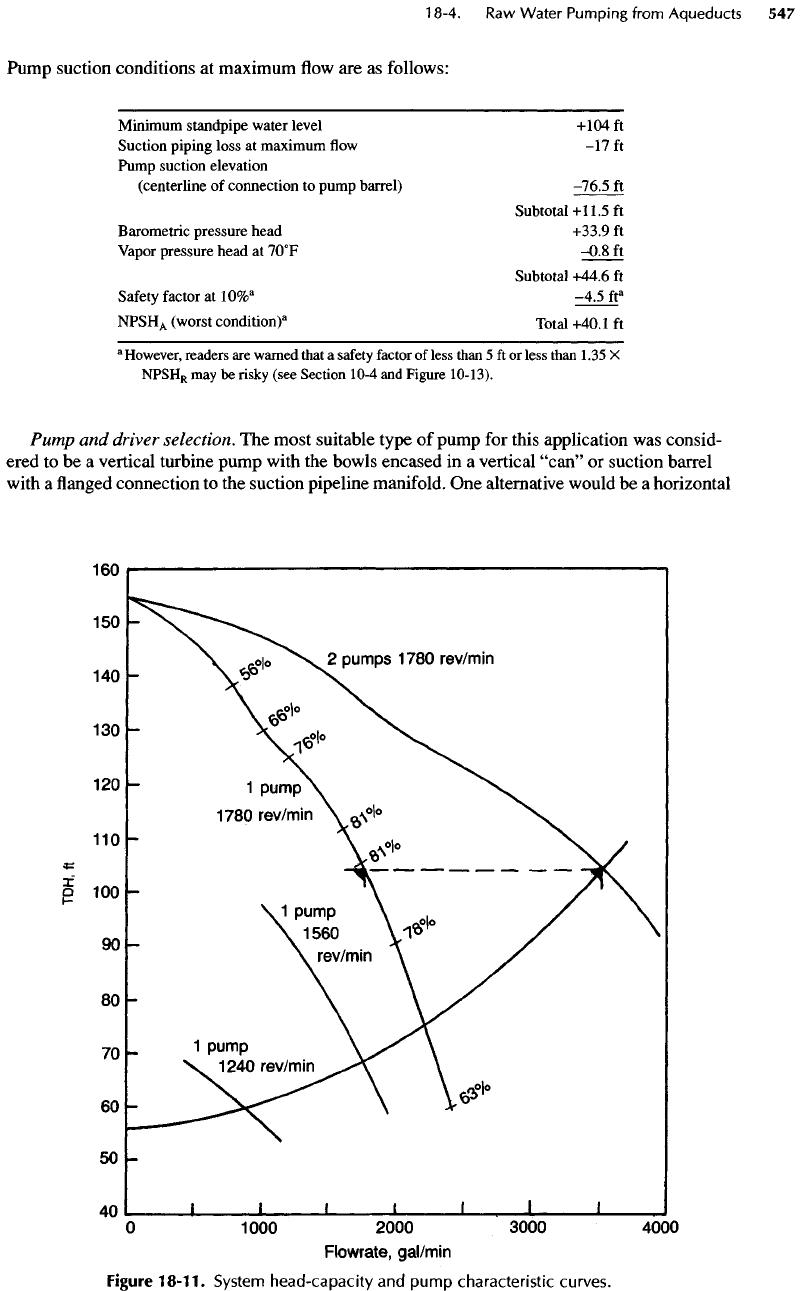
Pump
suction conditions
at
maximum
flow are as
follows:
Minimum
standpipe
water level
+104
ft
Suction piping
loss
at
maximum
flow
—17
ft
Pump suction elevation
(centerline
of
connection
to
pump barrel) -76.5
ft
Subtotal+11.5
ft
Barometric pressure head
+33.9
ft
Vapor pressure head
at
7O
0
F
-0.8ft
Subtotal
+44.6
ft
Safety
factor
at
10%
a
-4.5
ft
a
NPSH
A
(worst
condition)
3
Total
+40.1
ft
a
However,
readers
are
warned
that
a
safety
factor
of
less than
5 ft or
less
than
1.35
X
NPSH
R
may be risky
(see Section 10-4
and
Figure 10-13).
Pump
and
driver selection.
The
most suitable type
of
pump
for
this application
was
consid-
ered
to be a
vertical turbine pump with
the
bowls encased
in a
vertical "can"
or
suction barrel
with
a flanged
connection
to the
suction pipeline manifold.
One
alternative would
be a
horizontal
Figure
18-11.
System head-capacity
and
pump
characteristic curves.
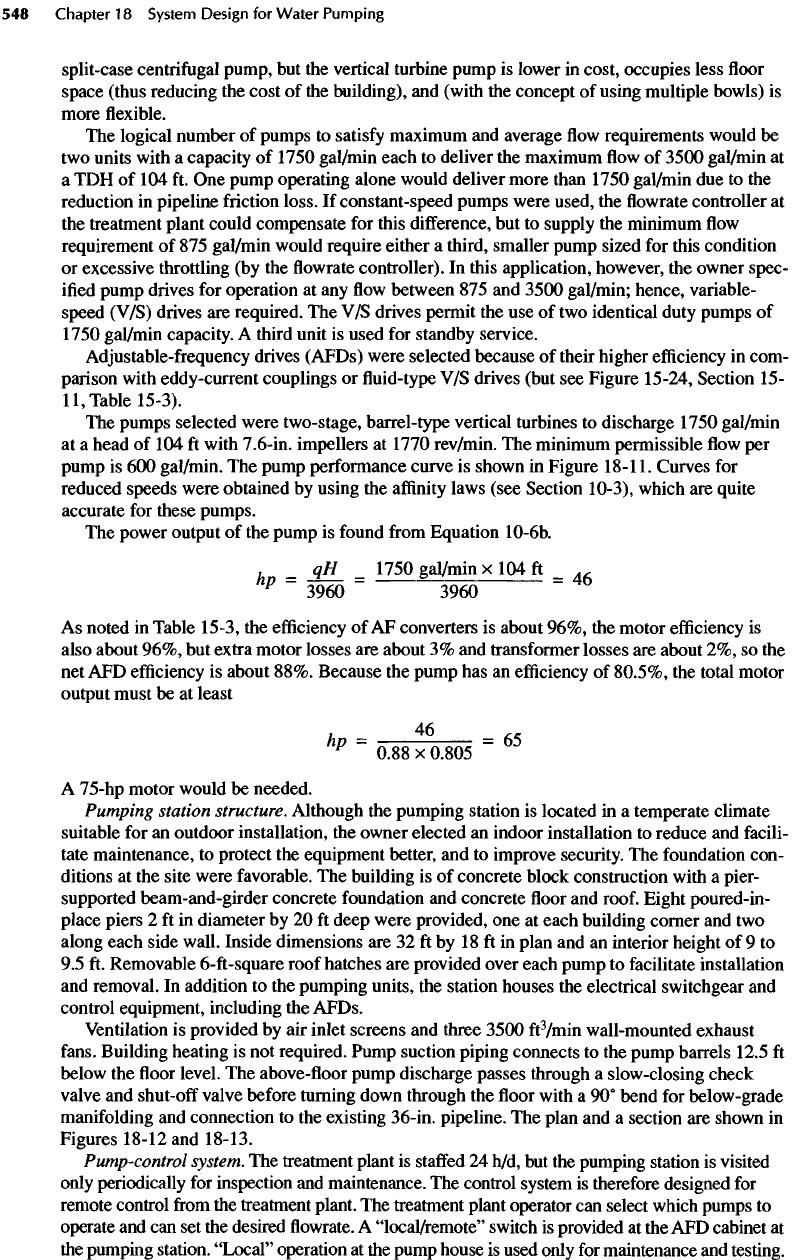
split-case
centrifugal
pump,
but the
vertical turbine pump
is
lower
in
cost,
occupies less
floor
space (thus reducing
the
cost
of the
building),
and
(with
the
concept
of
using multiple bowls)
is
more
flexible.
The
logical number
of
pumps
to
satisfy
maximum
and
average
flow
requirements would
be
two
units with
a
capacity
of
1750
gal/min
each
to
deliver
the
maximum
flow of
3500
gal/min
at
a
TDH of 104 ft. One
pump operating alone would deliver more than 1750 gal/min
due to the
reduction
in
pipeline
friction
loss.
If
constant-speed pumps were used,
the flowrate
controller
at
the
treatment plant could compensate
for
this difference,
but to
supply
the
minimum
flow
requirement
of 875
gal/min would require either
a
third, smaller pump sized
for
this condition
or
excessive throttling
(by the flowrate
controller).
In
this application, however,
the
owner
spec-
ified
pump drives
for
operation
at any flow
between
875 and
3500
gal/min; hence, variable-
speed (V/S) drives
are
required.
The V/S
drives permit
the use of two
identical duty pumps
of
1750 gal/min capacity.
A
third unit
is
used
for
standby service.
Adjustable-frequency
drives (AFDs) were
selected
because
of
their higher
efficiency
in
com-
parison with eddy-current couplings
or fluid-type V/S
drives (but
see
Figure 15-24, Section
15-
11,
Table 15-3).
The
pumps selected were two-stage, barrel-type vertical turbines
to
discharge 1750 gal/min
at
a
head
of 104 ft
with
7.6-in.
impellers
at
1770
rev/min.
The
minimum permissible
flow per
pump
is 600
gal/min.
The
pump performance curve
is
shown
in
Figure
18-11.
Curves
for
reduced speeds were obtained
by
using
the
affinity
laws (see Section
10-3),
which
are
quite
accurate
for
these pumps.
The
power output
of the
pump
is
found
from
Equation
10-6b.
,
qH
1750 gal/min
x 104 ft
__
„
P
3960
3960
As
noted
in
Table
15-3,
the
efficiency
of AF
converters
is
about 96%,
the
motor
efficiency
is
also about 96%,
but
extra motor
losses
are
about
3% and
transformer losses
are
about
2%, so the
net
AFD
efficiency
is
about 88%. Because
the
pump
has an
efficiency
of
80.5%,
the
total motor
output
must
be at
least
- 46
P
~
0.88x0.805
"
A
75-hp motor would
be
needed.
Pumping
station structure. Although
the
pumping station
is
located
in a
temperate climate
suitable
for an
outdoor installation,
the
owner
elected
an
indoor installation
to
reduce
and
facili-
tate maintenance,
to
protect
the
equipment better,
and to
improve security.
The
foundation con-
ditions
at the
site were favorable.
The
building
is of
concrete block construction with
a
pier-
supported
beam-and-girder
concrete foundation
and
concrete
floor and
roof.
Eight
poured-in-
place
piers
2 ft in
diameter
by 20 ft
deep were provided,
one at
each building corner
and two
along each side wall. Inside dimensions
are 32 ft by
18
ft in
plan
and an
interior height
of 9 to
9.5 ft.
Removable 6-ft-square roof hatches
are
provided over each pump
to
facilitate installation
and
removal.
In
addition
to the
pumping units,
the
station houses
the
electrical
switchgear
and
control equipment, including
the
AFDs.
Ventilation
is
provided
by air
inlet screens
and
three
3500
ft
3
/min
wall-mounted exhaust
fans.
Building heating
is not
required. Pump suction piping connects
to the
pump barrels 12.5
ft
below
the floor
level.
The
above-floor pump discharge passes through
a
slow-closing check
valve
and
shut-off
valve before turning down through
the floor
with
a 90°
bend
for
below-grade
manifolding
and
connection
to the
existing 36-in. pipeline.
The
plan
and a
section
are
shown
in
Figures 18-12
and
18-13.
Pump-control
system.
The
treatment plant
is
staffed
24
h/d,
but the
pumping station
is
visited
only
periodically
for
inspection
and
maintenance.
The
control system
is
therefore designed
for
remote control
from
the
treatment plant.
The
treatment plant operator
can
select which pumps
to
operate
and can set the
desired
flowrate. A
"local/remote"
switch
is
provided
at the AFD
cabinet
at
the
pumping station.
"Local"
operation
at the
pump house
is
used only
for
maintenance
and
testing.
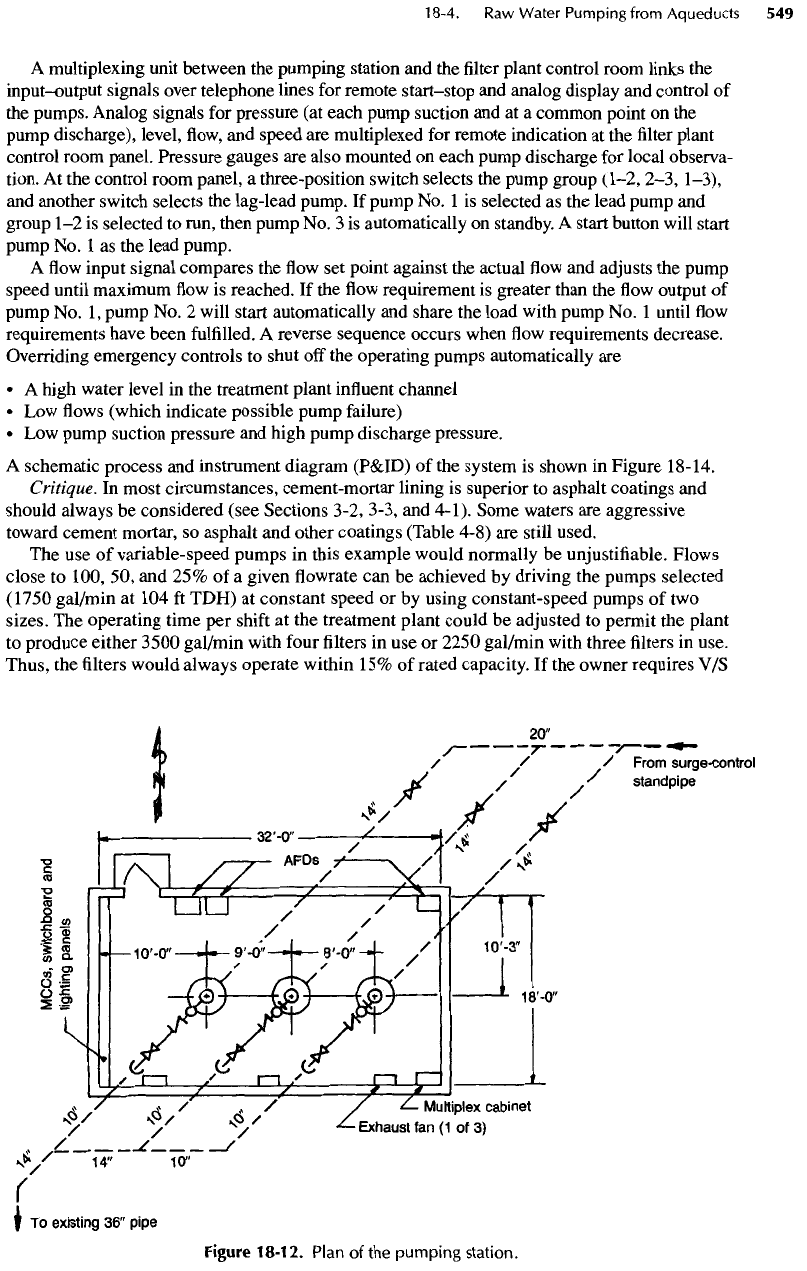
A
multiplexing unit between
the
pumping station
and the filter
plant control room links
the
input-output
signals over telephone lines
for
remote
start-stop
and
analog display
and
control
of
the
pumps. Analog signals
for
pressure
(at
each pump suction
and at a
common point
on the
pump
discharge), level,
flow, and
speed
are
multiplexed
for
remote indication
at the filter
plant
control room panel. Pressure gauges
are
also mounted
on
each pump discharge
for
local
observa-
tion.
At the
control room panel,
a
three-position switch selects
the
pump group
(1-2, 2-3, 1-3),
and
another switch selects
the
lag-lead pump.
If
pump
No. 1 is
selected
as the
lead pump
and
group
1-2 is
selected
to
run, then pump
No. 3 is
automatically
on
standby.
A
start button will start
pump
No. 1 as the
lead pump.
A
flow
input signal compares
the flow set
point against
the
actual
flow and
adjusts
the
pump
speed until maximum
flow is
reached.
If the flow
requirement
is
greater than
the flow
output
of
pump
No.
1,
pump
No. 2
will start automatically
and
share
the
load with pump
No. 1
until
flow
requirements have been
fulfilled.
A
reverse sequence occurs when
flow
requirements decrease.
Overriding emergency controls
to
shut
off
the
operating pumps automatically
are
• A
high water level
in the
treatment plant
influent
channel
• Low flows
(which indicate possible pump failure)
• Low
pump suction pressure
and
high pump discharge pressure.
A
schematic process
and
instrument diagram
(P&ID)
of the
system
is
shown
in
Figure 18-14.
Critique.
In
most circumstances, cement-mortar lining
is
superior
to
asphalt coatings
and
should always
be
considered
(see
Sections
3-2, 3-3,
and
4-1).
Some waters
are
aggressive
toward
cement mortar,
so
asphalt
and
other coatings (Table
4-8)
are
still used.
The use of
variable-speed
pumps
in
this example would normally
be
unjustifiable.
Flows
close
to
100,
50, and 25% of a
given
flowrate can be
achieved
by
driving
the
pumps selected
(1750
gal/min
at 104 ft
TDH)
at
constant
speed
or by
using constant-speed pumps
of two
sizes.
The
operating time
per
shift
at the
treatment plant could
be
adjusted
to
permit
the
plant
to
produce either
3500
gal/min
with
four
filters in use or
2250 gal/min with three
filters in
use.
Thus,
the filters
would always operate within
15%
of
rated capacity.
If the
owner requires
V/S
Figure
18-12.
Plan
of the
pumping station.
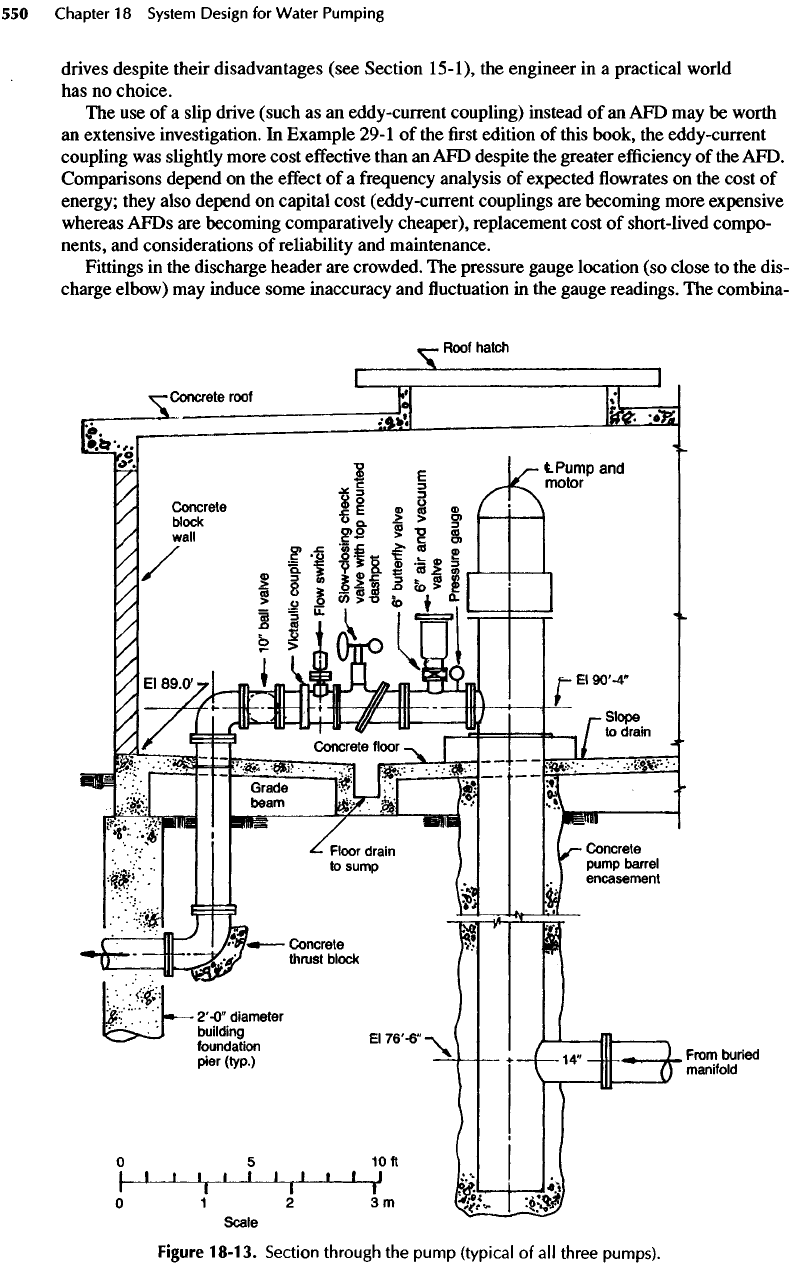
drives despite their disadvantages (see Section
15-1),
the
engineer
in a
practical world
has
no
choice.
The use of a
slip drive (such
as an
eddy-current coupling) instead
of an AFD may be
worth
an
extensive investigation.
In
Example
29-1
of the first
edition
of
this book,
the
eddy-current
coupling
was
slightly more
cost
effective
than
an AFD
despite
the
greater
efficiency
of the
AFD.
Comparisons depend
on the
effect
of a
frequency
analysis
of
expected
flowrates on the
cost
of
energy; they also depend
on
capital cost (eddy-current couplings
are
becoming more expensive
whereas AFDs
are
becoming comparatively cheaper), replacement cost
of
short-lived compo-
nents,
and
considerations
of
reliability
and
maintenance.
Fittings
in the
discharge header
are
crowded.
The
pressure gauge location
(so
close
to the
dis-
charge elbow)
may
induce some inaccuracy
and fluctuation in the
gauge readings.
The
combina-
Figure
18-13.
Section
through
the
pump
(typical
of all
three
pumps).
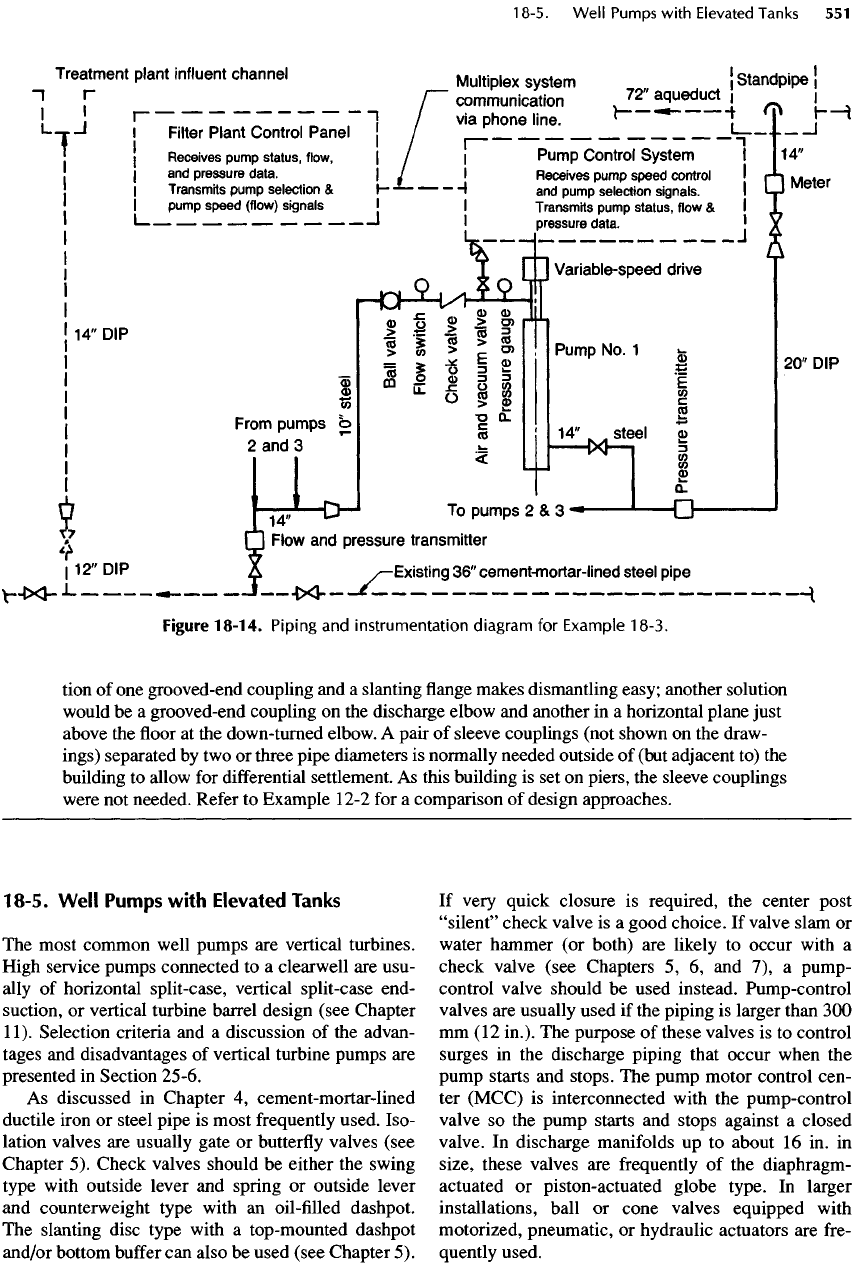
18-5.
Well
Pumps
with Elevated Tanks
The
most common well pumps
are
vertical turbines.
High
service pumps connected
to a
clearwell
are
usu-
ally
of
horizontal split-case, vertical split-case
end-
suction,
or
vertical turbine barrel design
(see
Chapter
11).
Selection criteria
and a
discussion
of the
advan-
tages
and
disadvantages
of
vertical turbine pumps
are
presented
in
Section
25-6.
As
discussed
in
Chapter
4,
cement-mortar-lined
ductile iron
or
steel pipe
is
most
frequently
used.
Iso-
lation valves
are
usually gate
or
butterfly
valves
(see
Chapter
5).
Check valves should
be
either
the
swing
type
with outside lever
and
spring
or
outside lever
and
counterweight type with
an
oil-filled
dashpot.
The
slanting disc type with
a
top-mounted dashpot
and/or
bottom
buffer
can
also
be
used
(see
Chapter
5).
If
very quick closure
is
required,
the
center post
"silent"
check valve
is a
good choice.
If
valve slam
or
water
hammer
(or
both)
are
likely
to
occur with
a
check valve
(see
Chapters
5, 6, and 7), a
pump-
control valve should
be
used instead. Pump-control
valves
are
usually
used
if the
piping
is
larger than
300
mm
(12
in.).
The
purpose
of
these valves
is to
control
surges
in the
discharge piping that occur when
the
pump starts
and
stops.
The
pump motor control
cen-
ter
(MCC)
is
interconnected with
the
pump-control
valve
so the
pump starts
and
stops against
a
closed
valve.
In
discharge manifolds
up to
about
16 in. in
size, these valves
are
frequently
of the
diaphragm-
actuated
or
piston-actuated globe type.
In
larger
installations, ball
or
cone valves equipped
with
motorized, pneumatic,
or
hydraulic actuators
are
fre-
quently used.
Figure
18-14.
Piping
and
instrumentation diagram
for
Example
18-3.
tion
of one
grooved-end coupling
and a
slanting
flange
makes dismantling easy; another solution
would
be a
grooved-end coupling
on the
discharge elbow
and
another
in a
horizontal plane just
above
the floor at the
down-turned elbow.
A
pair
of
sleeve couplings
(not
shown
on the
draw-
ings)
separated
by two or
three pipe diameters
is
normally needed outside
of
(but
adjacent
to) the
building
to
allow
for
differential
settlement.
As
this building
is set on
piers,
the
sleeve couplings
were
not
needed.
Refer
to
Example
12-2
for a
comparison
of
design approaches.
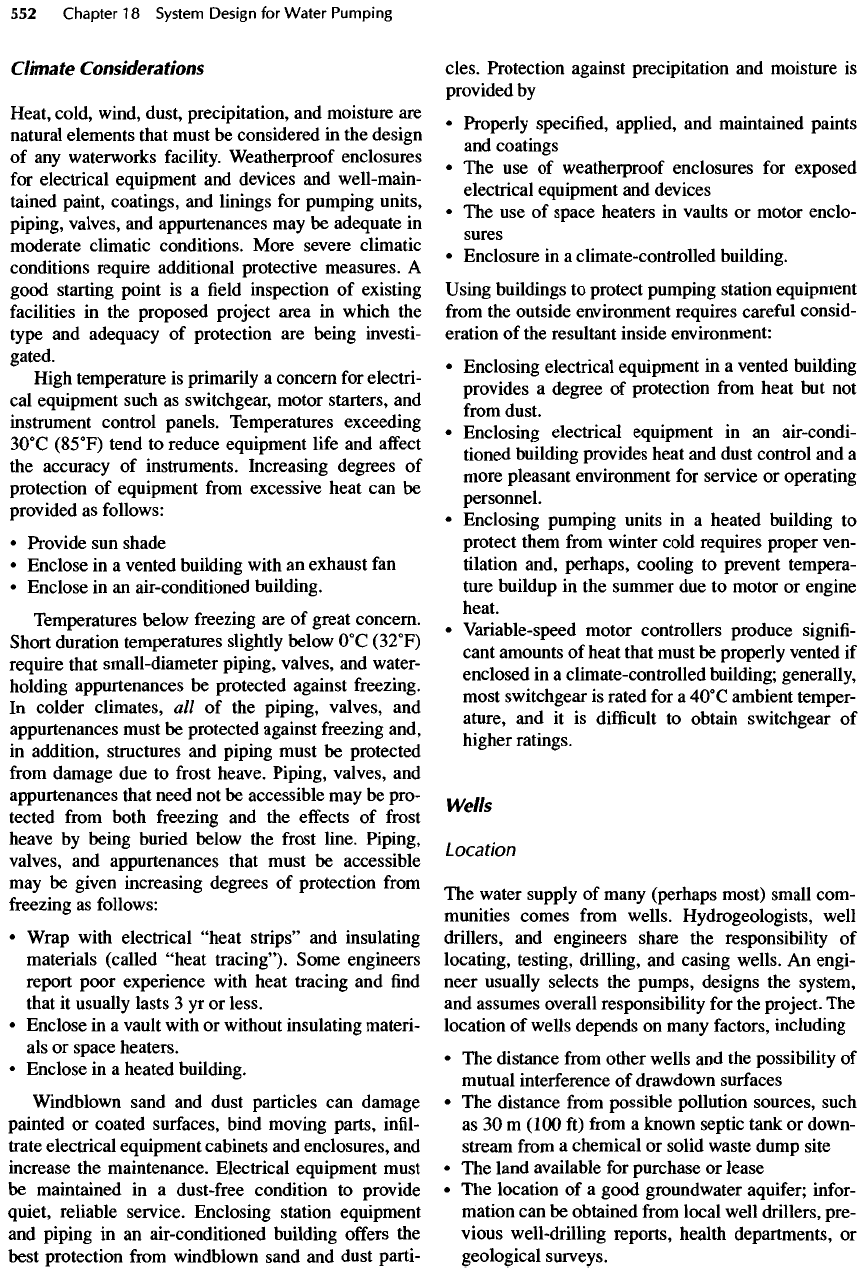
Climate
Considerations
Heat, cold, wind, dust, precipitation,
and
moisture
are
natural
elements that must
be
considered
in the
design
of
any
waterworks
facility.
Weatherproof enclosures
for
electrical
equipment
and
devices
and
well-main-
tained paint, coatings,
and
linings
for
pumping units,
piping, valves,
and
appurtenances
may be
adequate
in
moderate climatic conditions. More severe climatic
conditions require additional protective measures.
A
good starting point
is a field
inspection
of
existing
facilities
in the
proposed project area
in
which
the
type
and
adequacy
of
protection
are
being investi-
gated.
High
temperature
is
primarily
a
concern
for
electri-
cal
equipment such
as
switchgear, motor starters,
and
instrument
control panels. Temperatures exceeding
3O
0
C
(85
0
F)
tend
to
reduce equipment
life
and
affect
the
accuracy
of
instruments. Increasing degrees
of
protection
of
equipment
from
excessive heat
can be
provided
as
follows:
•
Provide
sun
shade
•
Enclose
in a
vented building with
an
exhaust
fan
•
Enclose
in an
air-conditioned building.
Temperatures
below
freezing
are of
great concern.
Short
duration temperatures slightly below
O
0
C
(32
0
F)
require that small-diameter piping, valves,
and
water-
holding
appurtenances
be
protected against freezing.
In
colder climates,
all of the
piping, valves,
and
appurtenances must
be
protected against freezing and,
in
addition, structures
and
piping must
be
protected
from
damage
due to
frost
heave. Piping, valves,
and
appurtenances
that need
not be
accessible
may be
pro-
tected
from
both freezing
and the
effects
of frost
heave
by
being buried below
the
frost
line. Piping,
valves,
and
appurtenances that must
be
accessible
may
be
given increasing degrees
of
protection
from
freezing
as
follows:
•
Wrap with electrical
"heat
strips"
and
insulating
materials (called "heat tracing"). Some engineers
report poor experience with heat tracing
and find
that
it
usually lasts
3 yr or
less.
•
Enclose
in a
vault
with
or
without insulating materi-
als
or
space heaters.
•
Enclose
in a
heated building.
Windblown
sand
and
dust particles
can
damage
painted
or
coated surfaces, bind moving parts,
infil-
trate electrical equipment cabinets
and
enclosures,
and
increase
the
maintenance. Electrical equipment must
be
maintained
in a
dust-free
condition
to
provide
quiet,
reliable service. Enclosing station equipment
and
piping
in an
air-conditioned building
offers
the
best protection
from
windblown sand
and
dust parti-
cles.
Protection against precipitation
and
moisture
is
provided
by
•
Properly specified, applied,
and
maintained paints
and
coatings
• The use of
weatherproof enclosures
for
exposed
electrical
equipment
and
devices
• The use of
space heaters
in
vaults
or
motor enclo-
sures
•
Enclosure
in a
climate-controlled building.
Using
buildings
to
protect pumping station equipment
from
the
outside environment requires
careful
consid-
eration
of the
resultant inside environment:
•
Enclosing electrical equipment
in a
vented building
provides
a
degree
of
protection
from
heat
but not
from
dust.
•
Enclosing electrical equipment
in an
air-condi-
tioned building provides heat
and
dust control
and a
more pleasant environment
for
service
or
operating
personnel.
•
Enclosing pumping units
in a
heated building
to
protect them
from
winter cold requires proper ven-
tilation and, perhaps, cooling
to
prevent tempera-
ture
buildup
in the
summer
due to
motor
or
engine
heat.
•
Variable-speed motor controllers produce
signifi-
cant
amounts
of
heat that must
be
properly vented
if
enclosed
in a
climate-controlled building; generally,
most
switchgear
is
rated
for a
4O
0
C
ambient temper-
ature,
and it is
difficult
to
obtain switchgear
of
higher ratings.
Wells
Location
The
water supply
of
many (perhaps most) small com-
munities
comes
from
wells.
Hydrogeologists,
well
drillers,
and
engineers share
the
responsibility
of
locating, testing, drilling,
and
casing wells.
An
engi-
neer usually selects
the
pumps, designs
the
system,
and
assumes overall responsibility
for the
project.
The
location
of
wells depends
on
many factors, including
• The
distance
from
other wells
and the
possibility
of
mutual
interference
of
drawdown surfaces
• The
distance
from
possible
pollution sources, such
as 30 m
(100
ft)
from
a
known septic tank
or
down-
stream
from
a
chemical
or
solid waste dump site
• The
land available
for
purchase
or
lease
• The
location
of a
good groundwater aquifer;
infor-
mation
can be
obtained
from
local
well drillers, pre-
vious well-drilling reports, health departments,
or
geological surveys.

Water
Quality
A
test well
is
normally drilled
to
determine
the
sus-
tained yield, drawdown distances,
and
water quality.
As
the
well
is
drilled,
a
soil
log is
kept
to
record soil
type
versus depth. This information, together with
an
electric well log,
is
used
to
determine
the
best water-
bearing soil strata.
The
electric well
log (a
measure
of
the
soil's
resistivity)
can be
used
by an
experienced
technician
to
determine
at
what soil strata levels
a
well
screen
should
be
positioned
to
provide
the
desired
yield.
In
several states, such records must
be
submit-
ted as
part
of the
permit process
for
wells.
A
chemical
analysis
of the
water
in
each aquifer should
be
made
to
select those aquifers
with
the
highest water quality
commensurate
with
suitable yield. Unwanted aquifers
can
be
sealed.
Water
Treatment
Well
waters usually have
a
high content
of
dissolved
solids
and are
usually
"hard."
Hard waters
can be
soft-
ened (and
often
demineralized
to
some extent)
by
lime-soda treatment,
or
they
can be
either softened
or
demineralized
by
such means
as ion
exchange
or
reverse osmosis
[7].
All of
these treatments
are
expen-
sive. Well waters
for
potable
use
should
be
chlorinated
even
if the
water
from
the
aquifer contains
no
bacte-
ria.
Because both wells
and
distribution systems
can
become contaminated, residual chlorine
is
needed
to
protect
the
public health. Unless
the
well water
is
clean
and
free
from
sand
and
silt,
a
settling basin
(or
even
a filter) is
required
for a
municipal well supply.
Many
wells contain gases (such
as
carbon dioxide,
methane, and/or hydrogen
sulfide)
that
can be
removed
by
aeration
or,
more completely,
by
vacuum.
Iron
and
manganese
can
also
be
removed
by
aeration,
lime-soda softening,
or
chlorination
followed
by fil-
tration,
or
they
can be
removed
by ion
exchange.
Casing
Wells
are
always
cased
—
usually
with steel.
The
cas-
ing
can be
placed against
the
soil,
or the
bore hole
can
be
enlarged
to
permit
the
placement
of a
layer
of
gravel, usually
at
least
150 mm (6
in.) thick, between
the
soil
and
casing.
The
"gravel
pack"
increases
the
yield
of the
well
and
reduces
the
velocity
of
inflow
at
the
face
of the
soil, which thereby reduces
the
inflow
of
sand
and
silt. Samples
of
water
and
soil
from
the
test
hole
can be
used
to
design
the
gravel pack
for
maximum
effectiveness
in
preventing
the
entrance
of
particulate
In the
aquifer,
the
casing
is
either perfo-
rated
at
closely spaced intervals
by a
special
tool
to
allow
water
to
enter
or the
casing
is
interrupted
by
well
screens.
Development
The
well
is
"developed"
by
pumping
at a
high rate
(considerably higher than normal pumping rates)
to
wash
fine
particles
out of the
aquifer
so
that
it can
behave
like
a
large, underloaded sand
filter
and, thus,
produce clear water. Some wells produce sparkling,
clear water; others never stop producing
silty
water.
During
a
well's development, nearby wells
or
bore
holes
can be
tested
to
establish
the
drawdown curve
and
to aid the
hydrogeologist
in
predicting
the
safe
yield. Walton
[8]
describes
groundwater tests
in
detail,
and
his
text
is
accompanied
by a
diskette containing
test programs
in
BASIC.
Well
Head
The
design
of the
valving system
at the
well head
is
critical. When
the
pump starts
after
a
period
of
rest,
the
water
(at
water table level)
flows at
high speed
to
the
well head because
the TDH is
initially zero.
If the
speed
is not
reduced
by the
cushion
of air in the
well,
the
pipe
or
well casing
may
break
and
pumps
may be
displaced.
The air
must
be
allowed
to
escape slowly
enough
so
that
the
moving column
of
water
in the
well
strikes
both
the
closed
check
(or
pump-control) valve
and
the
stationary column
of
water
in the
transmission
main
too
gently
to
cause
an
undue pressure surge.
If
the first
surge
of
water
from
the
aquifer contains sand
and
silt,
the
water
is
usually wasted. Valving arrange-
ments
for
well heads
are
shown
in
Figures 7-9, 7-10,
and
7-11
in
Section 7-6,
as
well
as in
Example 18-4.
Example
18-4
Design
of a
Deep
Well
Pumping
Station
Problem:
Maxwell (population
1800)
needs
a
second, reliable water source
at 500
gal/min
min-
imum.
The
well location selected
is
2000
ft
from
an
existing
100,000
gal
storage tank with
a low
water
level
107 ft and a
high water level
127
ft
above
the
ground, which
is
level between
the
well
and the
tank. Based
on the
results
of
well tests, well
screens
were placed between depths
of
595 to 605 ft and 720 to 724 ft. The
drawdown curve
is
shown
in
Figure
18-15.
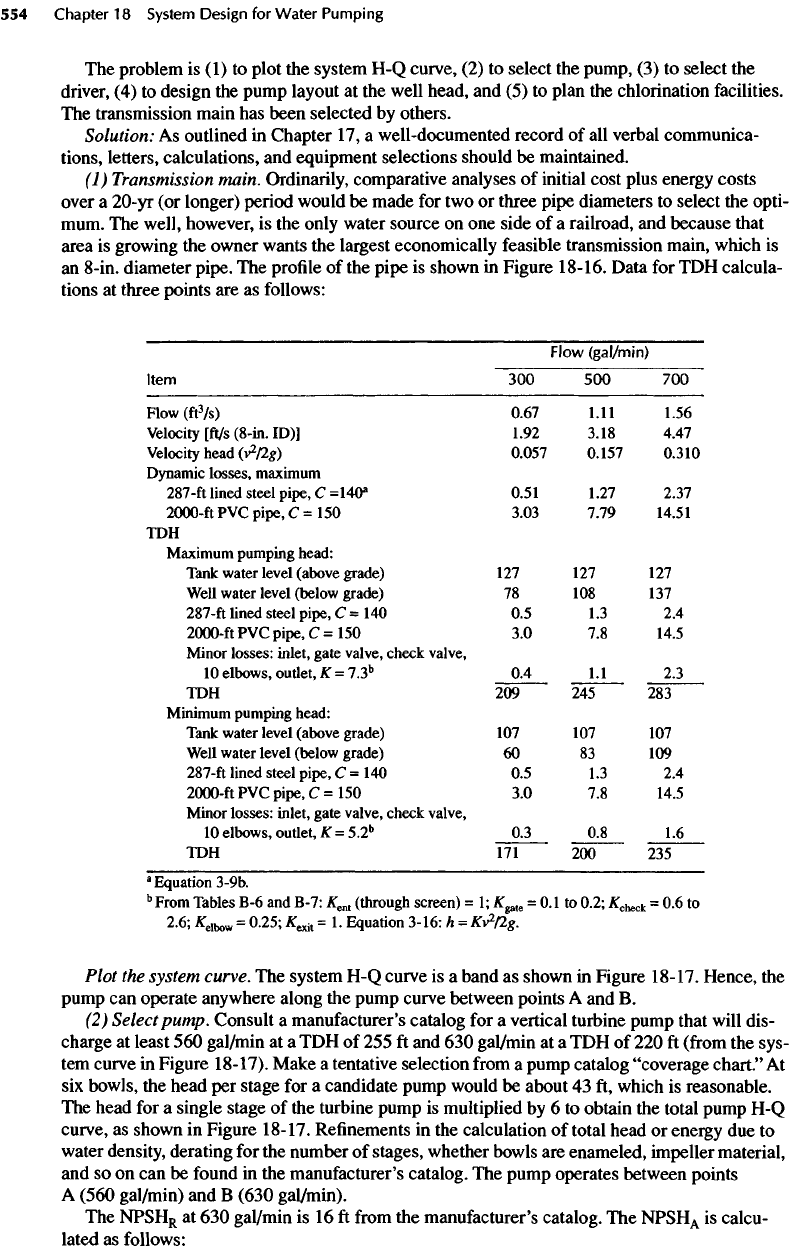
The
problem
is (1) to
plot
the
system
H-Q
curve,
(2) to
select
the
pump,
(3) to
select
the
driver,
(4) to
design
the
pump layout
at the
well head,
and (5) to
plan
the
chlorination
facilities.
The
transmission main
has
been
selected
by
others.
Solution:
As
outlined
in
Chapter
17, a
well-documented record
of all
verbal communica-
tions, letters, calculations,
and
equipment selections should
be
maintained.
(1)
Transmission
main. Ordinarily, comparative analyses
of
initial cost plus energy costs
over
a
20-yr
(or
longer) period would
be
made
for two or
three pipe diameters
to
select
the
opti-
mum.
The
well, however,
is the
only water source
on one
side
of a
railroad,
and
because that
area
is
growing
the
owner wants
the
largest economically feasible transmission main, which
is
an
8-in.
diameter pipe.
The
profile
of the
pipe
is
shown
in
Figure
18-16.
Data
for TDH
calcula-
tions
at
three points
are as
follows:
Flow
(gal/min)
Item
300
500
700
Flow(ft
3
/s)
0.67 1.11 1.56
Velocity
[ft/s
(8-in.
ID)] 1.92 3.18 4.47
Velocity
head
(V
2
^s)
0.057
0.157 0.310
Dynamic
losses,
maximum
287-ft
lined
steel
pipe,
C
=140
a
0.51 1.27 2.37
2000-ftPVCpipe,C=150
3.03 7.79 14.51
TDH
Maximum
pumping head:
Tank
water level (above grade)
127 127 127
Well
water level (below grade)
78 108 137
287-ft
lined
steel
pipe,
C
=
140 0.5 1.3 2.4
2000-ftPVCpipe,C=150
3.0 7.8
14.5
Minor
losses:
inlet, gate valve, check valve,
10
elbows,
outlet,
K =
7.3
b
0.4 1.1 2.3
TDH
209 245 283
Minimum
pumping head:
Tank
water level (above grade)
107 107 107
Well
water level (below grade)
60 83 109
287-ft
lined steel pipe,
C = 140 0.5
1.3
2.4
2000-ftPVCpipe,C=150
3.0 7.8
14.5
Minor
losses:
inlet, gate valve, check valve,
10
elbows,
outlet,
K =
5.2
b
0.3 0.8 1.6
TDH
171 200 235
a
Equation
3-9b.
b
From Tables
B-6 and
B-7:
K
601
(through screen)
=
1;
/$T
gate
=
0.1
to
0.2;
#
check
= 0.6 to
2.6;
tf
elbow
=
0.25;
tf
exit
= 1.
Equation
3-16:
h =
Kv
2
Vg.
Plot
the
system
curve.
The
system
H-Q
curve
is a
band
as
shown
in
Figure
18-17.
Hence,
the
pump
can
operate anywhere along
the
pump curve between points
A and
B.
(2)
Select pump. Consult
a
manufacturer's catalog
for a
vertical turbine pump that will
dis-
charge
at
least
560
gal/min
at a TDH of 255 ft and 630
gal/min
at a TDH of 220 ft
(from
the
sys-
tem
curve
in
Figure
18-17).
Make
a
tentative
selection
from
a
pump catalog "coverage
chart."
At
six
bowls,
the
head
per
stage
for a
candidate pump would
be
about
43 ft,
which
is
reasonable.
The
head
for a
single stage
of the
turbine pump
is
multiplied
by 6 to
obtain
the
total pump
H-Q
curve,
as
shown
in
Figure
18-17.
Refinements
in the
calculation
of
total head
or
energy
due to
water
density, derating
for the
number
of
stages, whether bowls
are
enameled, impeller material,
and
so on can be
found
in the
manufacturer's catalog.
The
pump operates between points
A
(560
gal/min)
and B
(630
gal/min).
The
NPSH
R
at 630
gal/min
is 16 ft
from
the
manufacturer's catalog.
The
NPSH
A
is
calcu-
lated
as
follows:
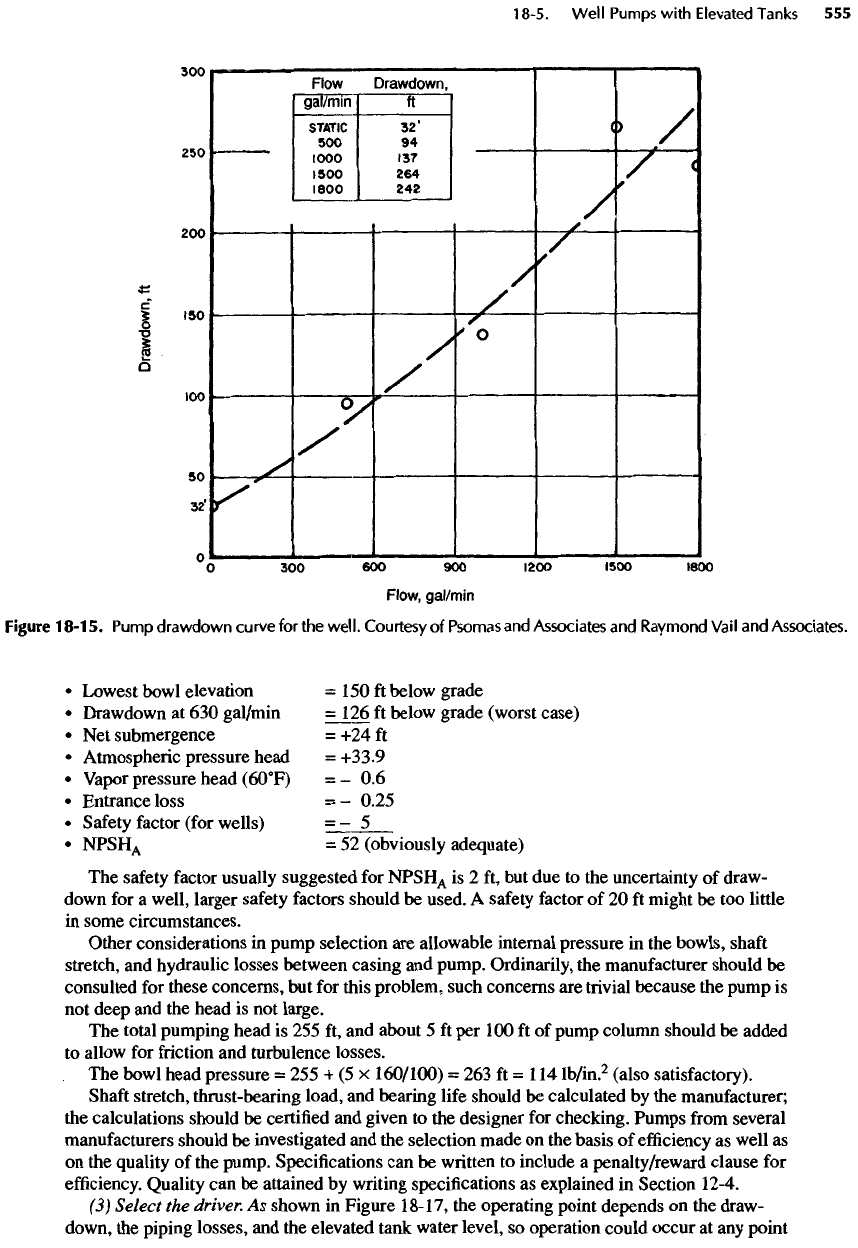
Figure
18-15.
Pump
drawdown
curve
for the
well.
Courtesy
of
Psomas
and
Associates
and
Raymond
Vail
and
Associates.
Lowest bowl elevation
= 150 ft
below grade
Drawdown
at 630
gal/min
= 126 ft
below grade (worst case)
Net
submergence
= +24 ft
Atmospheric pressure head
=
+33.9
Vapor
pressure head
(6O
0
F)
=-
0.6
Entrance loss
= -
0.25
Safety
factor (for wells)
=_-
5
NPSH
A
= 52
(obviously adequate)
The
safety
factor
usually suggested
for
NPSH
A
is 2 ft, but due to the
uncertainty
of
draw-
down
for a
well, larger
safety
factors should
be
used.
A
safety
factor
of 20 ft
might
be too
little
in
some circumstances.
Other considerations
in
pump
selection
are
allowable internal pressure
in the
bowls,
shaft
stretch,
and
hydraulic
losses
between casing
and
pump. Ordinarily,
the
manufacturer should
be
consulted
for
these concerns,
but for
this
problem,
such concerns
are
trivial because
the
pump
is
not
deep
and the
head
is not
large.
The
total pumping head
is 255 ft, and
about
5 ft per 100 ft of
pump column should
be
added
to
allow
for
friction
and
turbulence
losses.
The
bowl head pressure
= 255 + (5 x
160/100)
= 263 ft =
114
lb/in.
2
(also satisfactory).
Shaft
stretch, thrust-bearing load,
and
bearing
life
should
be
calculated
by the
manufacturer;
the
calculations should
be
certified
and
given
to the
designer
for
checking. Pumps
from
several
manufacturers
should
be
investigated
and the
selection
made
on the
basis
of
efficiency
as
well
as
on
the
quality
of the
pump. Specifications
can be
written
to
include
a
penalty/reward clause
for
efficiency.
Quality
can be
attained
by
writing specifications
as
explained
in
Section
12-4.
(3)
Select
the
driver.
As
shown
in
Figure
18-17,
the
operating point depends
on the
draw-
down,
the
piping losses,
and the
elevated tank water level,
so
operation could occur
at any
point
